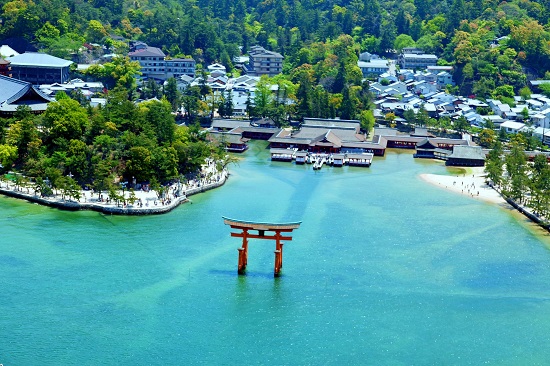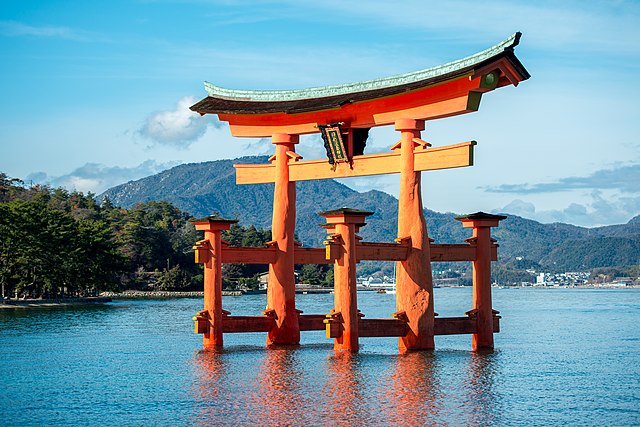Hiroshima Prefecture
Where is Hiroshima?
Hiroshima Prefecture is on the southern part of Honshu, Japan’s largest island.
It borders Okayama Prefecture to the east, Tottori Prefecture to the north east, Shimane Prefecture to the north and Yamaguchi Prefecture to the west.
The prefectures coast lies on the Seto Inland Sea with Ehime Prefecture on the island of Shikoku directly to the south.


The prefectural capital is Hiroshima City. Other cities in the prefecture include Kure and Fukuyama.
What is Hiroshima known for?
Hiroshima is most well known internationally as the location of the first atomic bomb dropped on Japan in 1945.
Today the Peace Memorial Park stands close to the location the bomb exploded with over 50 memorials and statues making it an important place for remembrance.

The prefecture is also home to the island of Miyajima which is home to Itsukushima Shrine.
The floating torii gate at the shrine is perhaps one of the most iconic locations in Japan, having been featured in many different forms of media for several decades.


Hiroshima is also home to the Japanese car manufacturer Mazda.
Where should I visit in Hiroshima?
Most visitors to Hiroshima will visit the Peace Memorial Park. A short 25 minute walk from JR Hiroshima Station, the park includes a large number of memorials to various groups affected by the atomic bomb dropped on the city.


As with many Japanese castle towns, Hiroshima Castle is a reconstruction of a 16th century castle containing a museum.
The castle grounds sit in Hiroshima’s Chuo Park and are considered to be one of the best areas for cherry blossom in the city.
Miyajima is a popular tourist attraction which can only be reached by ferry. Most visitors head to the island to view the floating torii gate at Itsukushima Shrine.


There are also a number of other attractions on Miyajima, including Senjokaku Pavilion, Daisho-in Temple, Momijidani Park and Mount Misen. Visitors heading to the top of Mount Misen can use the ropeway located in Momijidani Park.


Onomichi in Hiroshima Prefecture is the start point for many visitors to the Shimanami Kaido Bikeway. This 70km (43.5 mile) route crosses the Seto Inland Sea between Onomichi and Imabari in Ehime Prefecture.
The bikeway crosses a large number of bridges and islands with several bike depots along the route where bikes can be rented from or returned to.
When is the best time to visit Hiroshima?
The best time to visit Hiroshima Prefecture will depend on your itinerary and how it could be affected by the weather.
The coastal south of the prefecture is generally warm and dry throughout the year while the north is more mountainous and can see heavy snowfall in winter.
Spring (April to May) is typical of coastal Japan with mild temperatures and occasional rain. The cherry blossom season usually occurs in early to mid Spring.

Summer (June to August) brings high temperatures, typically up to 35°C (95°F). The rainy season runs from June to July so visitors should expect frequent showers.
Typhoon season runs from August to September each year.
Autumn (September to November) features low but mild temperatures and lower humidity levels compared to summer.
Winter (December to February) is usually mild with little snowfall on the coast but significant snow may fall further inland in mountain areas.
As Hiroshima is a coastal prefecture, it is worth bearing in mind that areas near the coast will typically have lower temperatures and higher humidity levels than areas further inland.
All Events in Hiroshima
Tours and Activities in Hiroshima
None found.
Where should I stay in Hiroshima?
As the largest city in the prefecture and close to the main tourist attractions, Hiroshima City offers the most hotel options for visitors as well as being the main hub for transportation throughout the prefecture.
Travelers on a budget who are visiting Hiroshima Prefecture are recommended to choose a budget or business hotel in Hiroshima City.
Many budget hotels from Japanese chains such as APA Hotel and Toyoko Inn can be found in convenient locations near Hiroshima Station.


Luxury accommodation can be found throughout Hiroshima City with luxury hotels such as Grand Prince Hotel Hiroshima and Hilton Hiroshima available.


If you plan to visit multiple prefectures, it can be beneficial (and often cost saving) to change your accommodation rather than commit to substantial cross country travel to visit each attraction.
This can be easy for visitors who are travelling light, but with many shinkansen services requiring advance booking for large luggage, it may be preferable to arrange luggage transfers through companies like Sagawa or Yamato Transport.

How do I get to Hiroshima Prefecture?
Some visitors may enter Hiroshima Prefecture on bikes or ferries via the Shimanami Kaido Bikeway, but the most common method to access the prefecture is via air or train.

Hiroshima Airport offers flights to domestic locations including Tokyo, Sapporo, Sendai and Okinawa, as well as a small number of international locations such as Seoul, Hong Kong, Guam, Taipei and Shanghai.
The San’yo Shinkansen stops at Hiroshima as it travels between Osaka and Hakata (Fukuoka City) allowing convenient travel from/to destinations including Fukuoka, Kitakyushu, Osaka, Kyoto, Yokohama and Tokyo.
The Sanyo Main Line railway offers local and express train services between Kitakyushu and Kobe which connect most of Hiroshima’s coastal cities and towns.

Express buses connect Hiroshima City with major cities in Japan such as Tokyo, Osaka, Nagoya and Fukuoka.
Express and local bus services also connect between the major cities in the prefecture and many larger towns.
This post may contain affiliate links, and Essential Japan may earn a commission if you purchase through them.
